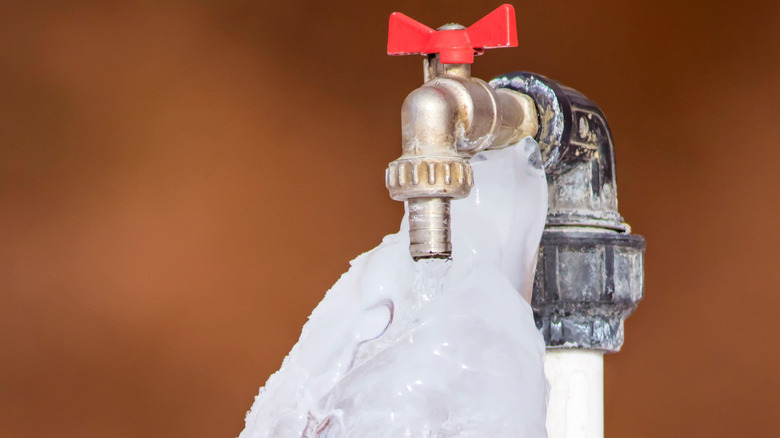How to Protect Plumbing System from Cold Weather: Key Advice
How to Protect Plumbing System from Cold Weather: Key Advice
Blog Article
Presented here underneath yow will discover some worthwhile details concerning How to prepare your home plumbing for winter weather.

Cold weather can wreak havoc on your pipes, specifically by freezing pipes. Here's just how to stop it from taking place and what to do if it does.
Intro
As temperatures decrease, the threat of icy pipes rises, potentially leading to expensive repairs and water damages. Comprehending just how to prevent icy pipelines is important for homeowners in cold environments.
Recognizing Icy Pipes
What creates pipes to freeze?
Pipes freeze when subjected to temperature levels listed below 32 ° F (0 ° C) for extended periods. As water inside the pipes freezes, it increases, taxing the pipeline wall surfaces and possibly creating them to break.
Threats and problems
Icy pipelines can cause supply of water disruptions, building damages, and costly repair services. Burst pipelines can flooding homes and trigger comprehensive architectural damage.
Indicators of Frozen Water Lines
Determining icy pipelines early can prevent them from breaking.
Exactly how to recognize frozen pipes
Look for reduced water flow from taps, uncommon odors or sounds from pipes, and noticeable frost on exposed pipes.
Avoidance Tips
Shielding prone pipelines
Cover pipelines in insulation sleeves or use warm tape to secure them from freezing temperature levels. Concentrate on pipes in unheated or outside locations of the home.
Heating methods
Maintain indoor spaces properly heated up, specifically locations with pipes. Open up cabinet doors to allow warm air to circulate around pipes under sinks.
Safeguarding Outside Pipes
Yard tubes and exterior taps
Separate and drain pipes yard hose pipes before winter season. Install frost-proof faucets or cover outside faucets with insulated caps.
What to Do If Your Pipelines Freeze
Immediate actions to take
If you think icy pipelines, maintain faucets open up to soothe stress as the ice melts. Make use of a hairdryer or towels soaked in hot water to thaw pipelines slowly.
Long-Term Solutions
Architectural modifications
Consider rerouting pipes far from exterior wall surfaces or unheated areas. Include added insulation to attics, cellars, and crawl spaces.
Upgrading insulation
Purchase top quality insulation for pipes, attic rooms, and wall surfaces. Proper insulation assists keep consistent temperature levels and lowers the risk of icy pipelines.
Conclusion
Stopping icy pipelines calls for aggressive steps and fast actions. By recognizing the causes, indications, and safety nets, property owners can secure their pipes throughout winter.
6 Proven Ways to Prevent Frozen Pipes and Protect Your Home
Disconnect and Drain Garden Hoses
Before winter arrives, start by disconnecting your garden hoses and draining any remaining water. Close the shut-off valves that supply outdoor hose bibs and leave the outdoor faucet open to allow any residual water to drain. For extra protection, consider using faucet covers throughout the colder months. It’s also important to drain water from any sprinkler supply lines following the manufacturer’s directions.
Insulate Exposed Pipes
Insulating your pipes is an effective way to prevent freezing. Pipe insulation is readily available at home improvement stores and is relatively inexpensive. Pay close attention to pipes in unheated areas such as the attic, basement, crawl spaces, or garage. Apply foam insulation generously to create a buffer against the cold. You can also wrap your pipes in heat tape or thermostat-controlled heat cables for added warmth.
Seal Air Leaks
Inspect your home for any cracks or openings that could let in cold air. Seal any holes around the piping in interior or exterior walls, as well as the sill plates where your home rests on its foundation. Additionally, make sure to keep your garage door closed unless you’re entering or exiting. Leaving it open creates a significant air leak that can lead to frozen pipes.
Allow Warm Air Circulation
During cold snaps, it’s essential to allow warm air to circulate evenly throughout your home. Leave interior doors ajar to promote better airflow. Open kitchen and bathroom cabinets to help distribute heat consistently around the rooms. If you have small children or pets, be sure to remove any household chemicals or potentially harmful cleaners from open cabinets for safety.
Let Faucets Drip
A small trickle of water can make a big difference in preventing ice formation inside your pipes. When temperatures drop significantly, start a drip of water from all faucets served by exposed pipes. This continuous flow helps prevent the water from freezing. Additionally, running a few faucets slightly can relieve pressure inside the pipes, reducing the chances of a rupture if the water inside does freeze.
https://choateshvac.com/6-proven-ways-to-prevent-frozen-pipes-and-protect-your-home/

As a keen person who reads on How To Avoid Freezing Pipes, I was thinking sharing that piece of content was worth the trouble. Feel free to take a moment to distribute this blog posting if you appreciated it. Many thanks for your time spent reading it.
Schedule Service Pickup Report this page